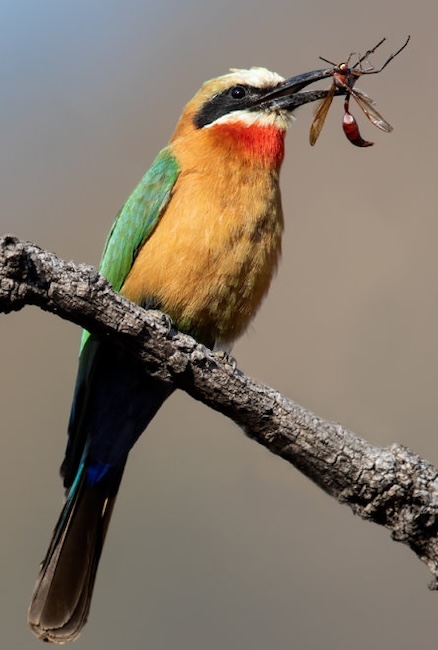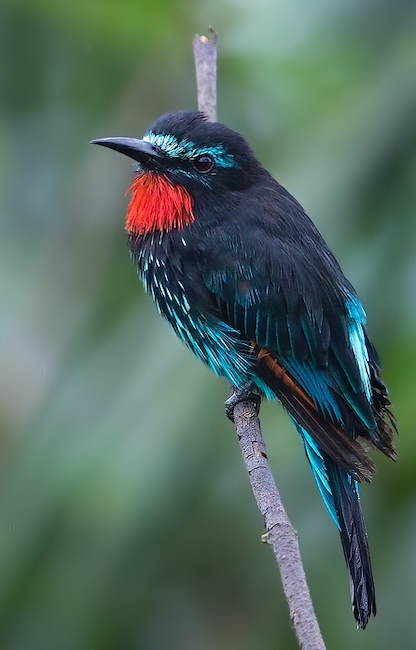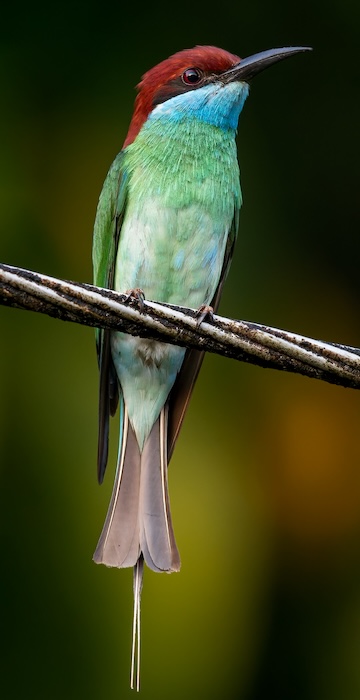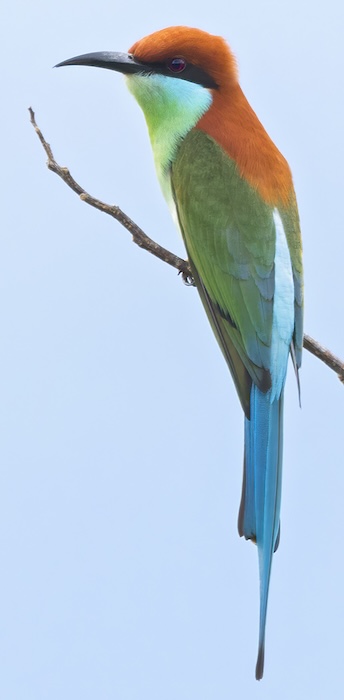Meropidae – Bee-eaters
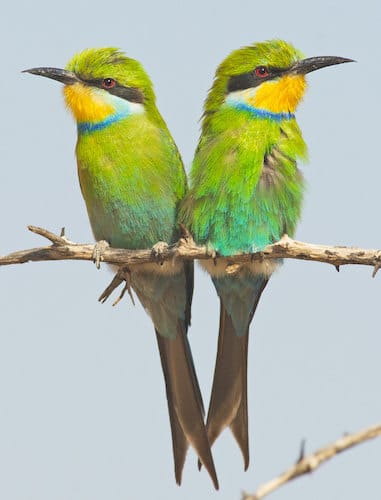
The Meropidae (Bee-eaters) are a small family (thirty-one species in three genera) of mostly, non-migratory near-passerine birds of the Old-World. They are Coraciiformes as are Brachypteraciidae (Ground Rollers), Coraciidae (Rollers), Momotidae (Motmots) and Alcedinidae (Kingfishers).
Most species are found in Africa and Asia, with a few in southern Europe, Australia, and New Guinea. They are characterised by richly coloured plumage, slender bodies, and usually elongated central tail feathers. All have long down-turned bills and medium to long wings, which may be pointed or round. Male and female plumages are usually similar.
|
|
|
|
White-fronted Bee-eater Merops bullockoides |
Black Bee-eater Merops gularis |
|
|
|
|
Blue-throated Bee-eater Merops viridis |
Rufous-crowned Bee-eater Merops americanus |
| All Photos in this intro ©Dubi Shapiro | |
As their name suggests, bee-eaters predominantly eat flying insects, especially bees and wasps, which are caught in the air by flights from an open perch. The stinger is removed by repeatedly hitting and rubbing the insect on a hard surface. During this process, pressure is applied to the insect thereby extracting most of the venom.
Most bee-eaters are gregarious. They form colonies, nesting in burrows tunnelled into vertical sandy banks, often at the side of a river, or in flat ground. As they mostly live in colonies, large numbers of nest holes may be seen together. The eggs are white, with typically five to the clutch. Most species are monogamous, and both parents care for the young, sometimes with assistance from related birds in the colony.
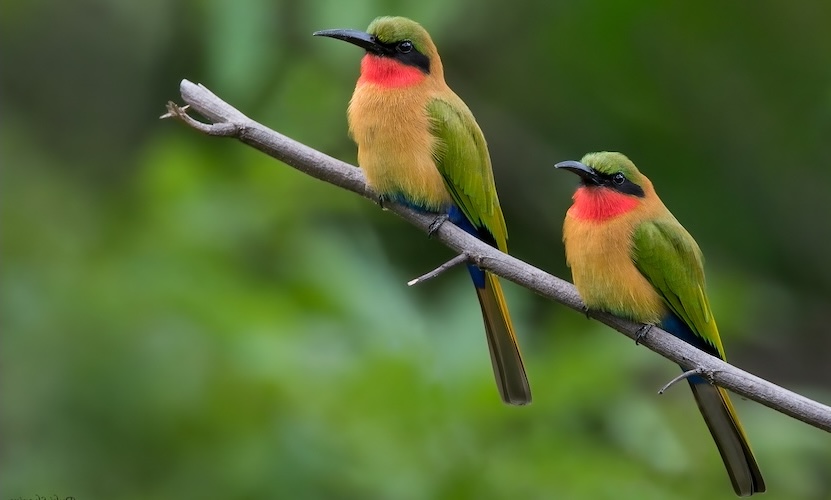
Red-throated Bee-eaters Merops bulocki
Bee-eaters may be killed by raptors, their nests are raided by rodents and snakes, and they can carry various parasites. Some species are adversely affected by human activity or habitat loss, but none meet the International Union for Conservation of Nature’s vulnerability criteria, and all are therefore evaluated as ‘least concern’.
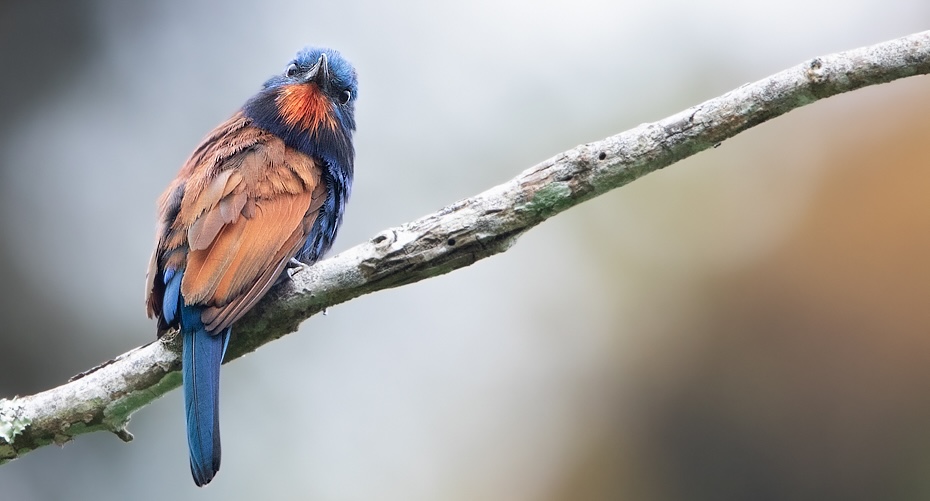
Blue-moustached Bee-eater Merops mentalis
Bee-eaters are fairly indiscriminate in their choice of habitat. Their requirements are simply an elevated perch from which to watch for prey and a suitable ground substrate in which to dig their breeding burrow. Because their prey is entirely caught on the wing, they are not dependent on any vegetation type.
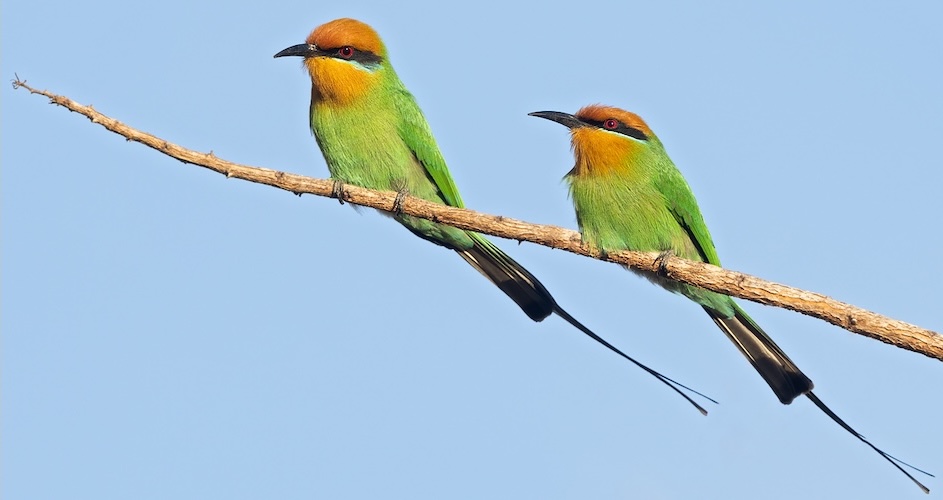
Böhm’s Bee-eaters Merops boehmi
A single species, the Blue-headed Bee-eater, is found inside closed rainforest where it forages close to the ground in poor light in the gaps between large trees. Six other species are also closely associated with rainforest, but occur in edge habitat such as along rivers, in tree-fall gaps, off trees overhanging ravines or on emergent tree crowns above the main canopy.
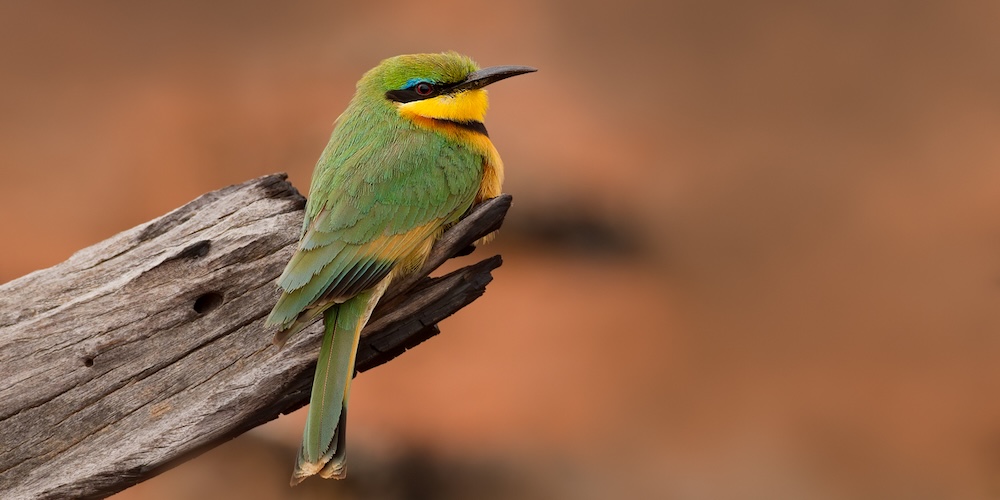
Little Bee-eater Merops pusillus
Their conspicuous appearance means that they have been mentioned by ancient writers and incorporated into mythology.
-
Number of bird species: 31
(As at September 2025)
According to the recently (2025) amalgamated AviList, there are thirty-one species in three genera in the Meropidae family. They are:
Red-bearded Bee-eater Nyctyornis amictus
Blue-bearded Bee-eater Nyctyornis athertoni
Purple-bearded Bee-eater Meropogon forsteni
Black-headed Bee-eater Merops breweri
White-fronted Bee-eater Merops bullockoides
Red-throated Bee-eater Merops bulocki
Somali Bee-eater Merops revoilii
Böhm’s Bee-eater Merops boehmi
Black Bee-eater Merops gularis
Blue-headed Bee-eater Merops muelleri
Blue-moustached Bee-eater Merops mentalis
Blue-breasted Bee-eater Merops variegatus
Little Bee-eater Merops pusillus
Swallow-tailed Bee-eater Merops hirundineus
Ethiopian Bee-eater Merops lafresnayii
Cinnamon-chested Bee-eater Merops oreobates
White-throated Bee-eater Merops albicollis
Rosy Bee-eater Merops malimbicus
Northern Carmine Bee-eater Merops nubicus
Southern Carmine Bee-eater Merops nubicoides
Chestnut-headed Bee-eater Merops leschenaulti
Blue-throated Bee-eater Merops viridis
Rufous-crowned Bee-eater Merops americanus
African Green Bee-eater Merops viridissimus
Arabian Green Bee-eater Merops cyanophrys
Asian Green Bee-eater Merops orientalis
European Bee-eater Merops apiaster
Rainbow Bee-eater Merops ornatus
Blue-tailed Bee-eater Merops philippinus
Olive Bee-eater Merops superciliosus
Blue-cheeked Bee-eater Merops persicus
-
Kingfishers, Bee-eaters & Rollers
| By C Hiliary Fry, Kathie Fry & Alan Harris | Helm | 1992 | ISBN: 9780713680287 Buy this book from NHBS.com -
The Bee Eaters
| By C Hilary Fry | T & AD Poyser | 2010 | Hardback | 320 pages, Col plates,drawings,maps | ISBN: 9781408136867 Buy this book from NHBS.com
-
Meropidae
Family AccountBee-eaters are perhaps the most graceful aerial insectivores of the Eastern Hemisphere. -
Meropidae
Family AccountThe bee-eaters are a group of birds in the family Meropidae, containing three genera and thirty-one species.
Given that this is a medium sized family with thirty species in only three genera, Fatbirder provides active links below to all species.
-
African Green Bee-eater Merops viridissimus
Species AccountA small, dainty bee-eater of open woodlands, semideserts, farmland, and around sparse human habitation. -
African Green Bee-eater Merops viridissimus
Species AccountSound archive and distribution map. -
Arabian Green Bee-eater Merops cyanophrys
Species AccountThe Arabian green bee-eater (Merops cyanophrys) is a species of bird in the family Meropidae. -
Arabian Green Bee-eater Merops cyanophrys
Species AccountSound archive and distribution map. -
Asian Green Bee-eater Merops orientalis
Species AccountThe Asian green bee-eater (Merops orientalis), also known as the little green bee-eater, and just green bee-eater in Sri Lanka, is a bird species... -
Asian Green Bee-eater Merops orientalis
Species AccountSound archive and distribution map. -
Black Bee-eater Merops gularis
Species AccountA bee-eater of forest and forest edge that appears entirely black at a distance, but in good light shows a bright red throat and electric blue belly. -
Black Bee-eater Merops gularis
Species AccountSound archive and distribution map. -
Black-headed Bee-eater Merops breweri
Species AccountThe black-headed bee-eater (Merops breweri) is a species of bird in the family Meropidae. It is found in forests in tropical Central and West Africa. -
Black-headed Bee-eater Merops breweri
Species AccountSound archive and distribution map. -
Blue-bearded Bee-eater Nyctyornis athertoni
Species AccountA large bee-eater which appears greenish overall. Note the bluish-green forehead, the long blue streak down the throat to the breast, and the dull yellow belly... -
Blue-bearded Bee-eater Nyctyornis athertoni
Species AccountSound archive and distribution map. -
Blue-breasted Bee-eater Merops variegatus
pecies AccountThe blue-breasted bee-eater (Merops variegatus) is a central African species of bird. It is a member of the family Meropidae. -
Blue-breasted Bee-eater Merops variegatus
pecies AccountSound archive and distribution map. -
Blue-cheeked Bee-eater Merops persicus
Species AccountA lime-green bee-eater with a thin black mask edged with aquamarine blue. Bright yellow-and-red throat patch is small compared to many other bee-eaters. -
Blue-cheeked Bee-eater Merops persicus
Species AccountSound archive and distribution map. -
Blue-headed Bee-eater Merops muelleri
Species AccountThe blue-headed bee-eater (Merops muelleri) is a species of bird in the family Meropidae. It is found in forest habitats in tropical West and Central Africa. -
Blue-headed Bee-eater Merops muelleri
Species AccountSound archive and distribution map. -
Blue-moustached Bee-eater Merops mentalis
Species AccountSound archive and distribution map. -
Blue-moustached Bee-eater Merops mentalis
Species AccountAn easily overlooked forest bee-eater of West and Central Africa, often found in the forest interior and near forest edge or tree-fall gaps. -
Blue-tailed Bee-eater Merops philippinus
Species AccountElegant, slender bird of open country, frequently seen in flight or perched on exposed snags or telephone wires. -
Blue-tailed Bee-eater Merops philippinus
Species AccountSound archive and distribution map. -
Blue-throated Bee-eater Merops viridis
Species AccountA bright green insect hunter with a long bill and triangular starling-like wings. Adult has a bright blue throat, orange-brown crown and nape, and long -
Blue-throated Bee-eater Merops viridis
Species AccountBlue-throated Bee-eater Merops viridis has most recently been assessed for The IUCN Red List of Threatened Species in 2016. Merops viridis is li -
Blue-throated Bee-eater Merops viridis
Species AccountSound archive and distribution map. -
Böhm’s Bee-eater Merops boehmi
Species AccountBöhm's bee-eater (Merops boehmi) is a species of bird in the family Meropidae. It is found in Democratic Republic of the Congo, Malawi, Mozambique, Tanzania... -
Böhm’s Bee-eater Merops boehmi
Species AccountSound archive and distribution map. -
Chestnut-headed Bee-eater Merops leschenaulti
Species AccountThe chestnut-headed bee-eater (Merops leschenaulti), or bay-headed bee-eater, is a bird in the bee-eater family Meropidae. -
Chestnut-headed Bee-eater Merops leschenaulti
Species AccountSound archive and distribution map. -
Cinnamon-chested Bee-eater Merops oreobates
Species AccountColorful, medium-sized bee-eater with rich rufous underparts. In flight, shows black patches at the back of the wings and sides of the tail. -
Cinnamon-chested Bee-eater Merops oreobates
Species AccountSound archive and distribution map. -
Ethiopian Bee-Eater Merops lafresnayii
Species AccountBeautiful bee-eater with a blue fore-crown, green back, yellow throat, rufous underparts, and deep-blue breast band. -
Ethiopian Bee-Eater Merops lafresnayii
Species AccountThe Ethiopian bee-eater (Merops lafresnayii) is a species of bird in the family Meropidae. It is found in Ethiopia and Sudan. -
Ethiopian Bee-Eater Merops lafresnayii
Species AccountEthiopian Bee-eater Merops lafresnayii has most recently been assessed for The IUCN Red List of Threatened Species in 2016. Merops lafresnayii is listed as Least Concern. -
Ethiopian Bee-Eater Merops lafresnayii
Species AccountSound archive and distribution map. -
European Bee-eater Merops apiaster
Species AccountSound archive and distribution map. -
European Bee-eater Merops apiaster
Species AccountThe European bee-eater (Merops apiaster) is a near passerine bird in the bee-eater family Meropidae. The genus name Merops is Ancient Greek for "bee-eater", and apiaster is Latin, also meaning "bee-eater", from apis, "bee".[2] It breeds in southern Europe and in parts of north Africa and western Asia. It is strongly migratory, wintering in tropical Africa. This species occurs as a spring overshoot north of its range, with occasional breeding in northwest Europe. -
European Bee-eater Merops apiaster
Species AccountEuropean Bee-eater Merops apiaster has most recently been assessed for The IUCN Red List of Threatened Species in 2016. Merops apiaster is listed as Least Concern. -
Little Bee-eater Merops pusillus
pecies AccountThe little bee-eater (Merops pusillus) is a bird species in the bee-eater family, Meropidae. They are found in Sub-Saharan Africa. -
Little Bee-eater Merops pusillus
pecies AccountSound archive and distribution map. -
Northern Carmine Bee-eater Merops nubicus
Species AccountLarge and gorgeous bee-eater with a mostly carmine body, and blue-green head and belly. The central tail feathers are elongated. -
Northern Carmine Bee-eater Merops nubicus
Species AccountSound archive and distribution map. -
Olive Bee-eater Merops superciliosus
Species AccountThe olive bee-eater or Madagascar bee-eater (Merops superciliosus) is a bee-eater species in the genus Merops. -
Olive Bee-eater Merops superciliosus
Species AccountSound archive and distribution map. -
Purple-bearded Bee-eater Meropogon forsteni
Species AccountSound archive and distribution map. -
Purple-bearded Bee-eater Meropogon forsteni
Species AccountThe purple-bearded bee-eater or Celebes bee-eater (Meropogon forsteni) is a species of bee-eater endemic to the island of Sulawesi, Indonesia. -
Purple-bearded Bee-eater Meropogon forsteni
Species AccountAn unmistakable large bee-eater with elongated central tail feathers, a green back and uppertail, and a diagnostic deep purple face and throat. -
Rainbow Bee-Eater Merops ornatus
Species AccountThe rainbow bee-eater (Merops ornatus) is a bird species in the bee-eater family Meropidae. Rainbow bee-eater. Perching on a drinking fountain in Cairns... -
Rainbow Bee-Eater Merops ornatus
Species AccountRainbow Bee-eater Merops ornatus has most recently been assessed for The IUCN Red List of Threatened Species in 2016. Merops ornatus is listed as Least Concern. -
Rainbow Bee-Eater Merops ornatus
Species AccountSound archive and distribution map. -
Red-bearded Bee-eater Nyctyornis amictus
Species AccountThe red-bearded bee-eater (Nyctyornis amictus) is a large species of bee-eater found in southern Myanmar, the Thai-Malay Peninsula, Borneo, Sumatra and nearby... -
Red-bearded Bee-eater Nyctyornis amictus
Species AccountSound archive and distribution map. -
Red-throated Bee-eater Merops bulocki
Species AccountA pretty, medium-sized bee-eater with a red throat and a blue lower belly. Also note the black face mask, green upperparts, and pale orange... -
Red-throated Bee-eater Merops bulocki
Species AccountSound archive and distribution map. -
Rosy Bee-eater Merops malimbicus
pecies AccountThe rosy bee-eater (Merops malimbicus) is a species of bird in the family Meropidae. It is found in Angola, Benin, Burkina Faso... -
Rosy Bee-eater Merops malimbicus
pecies AccountSound archive and distribution map. -
Rufous-crowned Bee-eater Merops americanus
Species AccountA medium-sized, long-tailed bee-eater of open areas. Pale green below with deep green wings; pale blue above and below the base of the tail and below the black... -
Rufous-crowned Bee-eater Merops americanus
Species AccountThe rufous-crowned bee-eater (Merops americanus) is a species of bird in the family Meropidae. It is endemic to the Philippines, where it is widely distributed. -
Rufous-crowned Bee-eater Merops americanus
Species AccountRufous-crowned Bee-eater Merops americanus has most recently been assessed for The IUCN Red List of Threatened Species in 2016. Merops americanus is listed as Least Concern. -
Somali Bee-eater Merops revoilii
pecies AccountA small, relatively drab bee-eater of arid country. Note the blue eyebrow, black face mask, white throat, and buffy underparts. -
Somali Bee-eater Merops revoilii
pecies AccountSound archive and distribution map. -
Southern Carmine Bee-eater Merops nubicoides
Species AccountThe southern carmine bee-eater (Merops nubicoides) (formerly carmine bee-eater) occurs across sub-equatorial Africa, ranging from KwaZulu-Natal and Namibia to Gabon, eastern Democratic Republic of the Congo and Kenya. -
Southern Carmine Bee-eater Merops nubicoides
Species AccountSound archive and distribution map. -
Swallow-tailed Bee-eater Merops hirundineus
Species AccountBeautiful mid-sized bee-eater with a deeply-forked blue tail. Immature has duller coloration but still has distinctive tail shape. -
Swallow-tailed Bee-eater Merops hirundineus
Species AccountSound archive and distribution map. -
White-fronted Bee-eater Merops bullockoides
Species AccountThe white-fronted bee-eater (Merops bullockoides) is a species of bee-eater widely distributed in sub-equatorial Africa. -
White-fronted Bee-eater Merops bullockoides
Species AccountSound archive and distribution map. -
White-throated Bee-eater Merops albicollis
Species AccountBirdLife species account… -
White-throated Bee-eater Merops albicollis
Species AccountThe white-throated bee-eater (Merops albicollis) is a near passerine bird in the bee-eater family Meropidae. It breeds in semi-desert along the southern edge of the Sahara, Africa. The white-throated bee-eater is migratory, wintering in a completely different habitat in the equatorial rainforests of Africa from southern Senegal to Uganda. -
White-throated Bee-eater Merops albicollis
Species AccountWhite-throated Bee-eater Merops albicollis has most recently been assessed for The IUCN Red List of Threatened Species in 2016. Merops albicollis is listed as Least Concern. -
White-throated Bee-eater Merops albicollis
Species AccountSound archive and distribution map.

